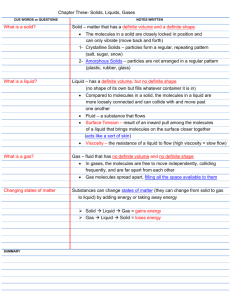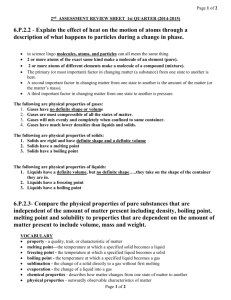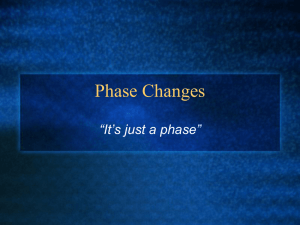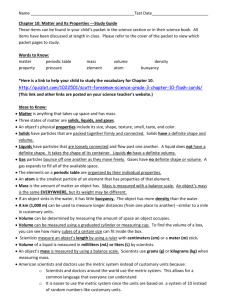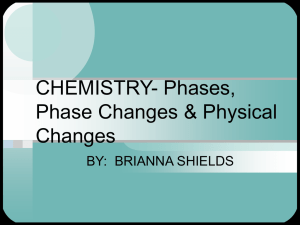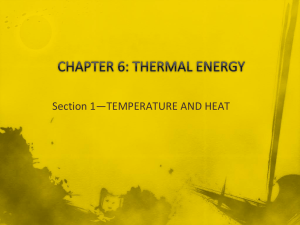Unit 4 - Binghamton City Schools
advertisement
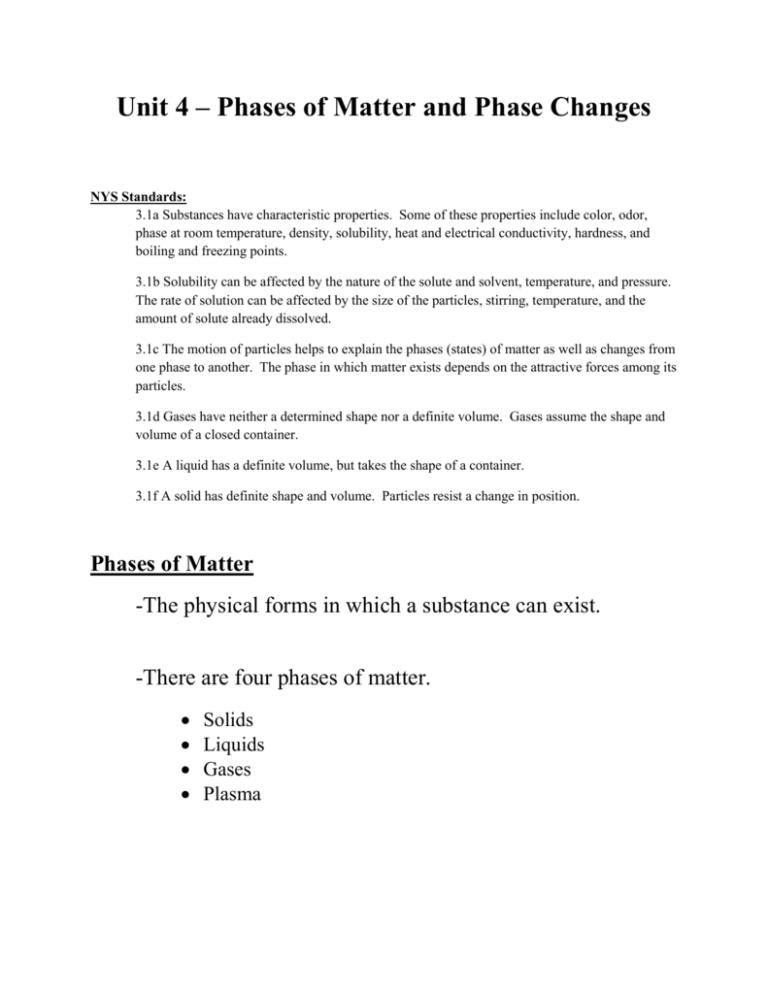
Unit 4 – Phases of Matter and Phase Changes NYS Standards: 3.1a Substances have characteristic properties. Some of these properties include color, odor, phase at room temperature, density, solubility, heat and electrical conductivity, hardness, and boiling and freezing points. 3.1b Solubility can be affected by the nature of the solute and solvent, temperature, and pressure. The rate of solution can be affected by the size of the particles, stirring, temperature, and the amount of solute already dissolved. 3.1c The motion of particles helps to explain the phases (states) of matter as well as changes from one phase to another. The phase in which matter exists depends on the attractive forces among its particles. 3.1d Gases have neither a determined shape nor a definite volume. Gases assume the shape and volume of a closed container. 3.1e A liquid has a definite volume, but takes the shape of a container. 3.1f A solid has definite shape and volume. Particles resist a change in position. Phases of Matter -The physical forms in which a substance can exist. -There are four phases of matter. Solids Liquids Gases Plasma Solids – Phase of matter in which matter has a definite shape and volume. Molecules (small round objects) are arranged and organized in “tightly packed” order. The molecules in solids vibrate in place. Liquids – Phase of matter in which matter takes the shape of its container and has definite volume. Molecules are moving slowly; not fast enough to overcome the attractions between them. The molecules in liquids slide past one another. Gases – Phase in which matter changes in both volume and shape. Molecules move very quickly and are able to break apart from one another. Plasma – Phase of matter that does not have a definite shape or volume and whose particles have broken apart. Examples of plasma are: lightning, fire and the Aurora Borealis (Northern Lights) The arrangement of molecules in solids, liquids and gases. Why do different phases of matter exist? Different phases of matter exist because of the behavior of molecules. Molecules are too small to see but they are always in motion, constantly bumping into one another. We classify the different phases of matter based on how fast the molecules move or how the matter is arranged. o Solids – Molecules move slowly and vibrate in place. o Liquids – Move faster than solids and overcome some attraction (slide). o Gases – Move fast and overcome all of the attraction. o Plasma – Move incredibly fast but break apart. Changes of State -There are six major changes of state. Freezing Melting Boiling Evaporation Condensation Sublimation Freezing – The change of state from a liquid to a solid. o As liquids cool their particles begin to slow, bringing them closer together. o The freezing point of water is 0oC o Freezing is a loss of thermal energy. Melting – The change of state from a solid to a liquid. o As a substance absorbs heat energy the objects particles begin to heat up and move faster and farther away from one another. o The melting point of water is 0oC o Melting is a gain of thermal energy. Boiling – Process that occurs when vaporization takes place inside a liquid as well as on the surface. o Dependent on how strongly the particles in the object are held together. o The boiling point of water is 100oC o Boiling is a gain of thermal energy. Evaporation – Occurs when a liquid acquires enough energy to become a gas only on the surface of a liquid. o Evaporation is a gain of thermal energy. Condensation – Occurs when a gas loses enough thermal energy to become a liquid. o Particles in a gas lose energy and begin to move slower, coming closer together. o Condensation is a loss of thermal energy. Sublimation – Occurs when the surface particles of a solid gain enough energy to become a gas. o The object goes directly from a solid to a gas skipping the liquid phase. Ex. Dry Ice o Sublimation is a gain of thermal energy. What happens when things melt, boil, etc.? o During a phase change, Thermal energy is either absorbed or released. Solid to a Liquid and a Liquid to a Gas both Absorb Thermal Energy. Gas to a Liquid and Liquid to a Solid both Release Thermal Energy. What happens to substances when they are heated or cooled? o When objects are heated they Expand. o When objects are cooled the Contract. Water is the only exception. It actually expands as it cools. Change of State Graph


